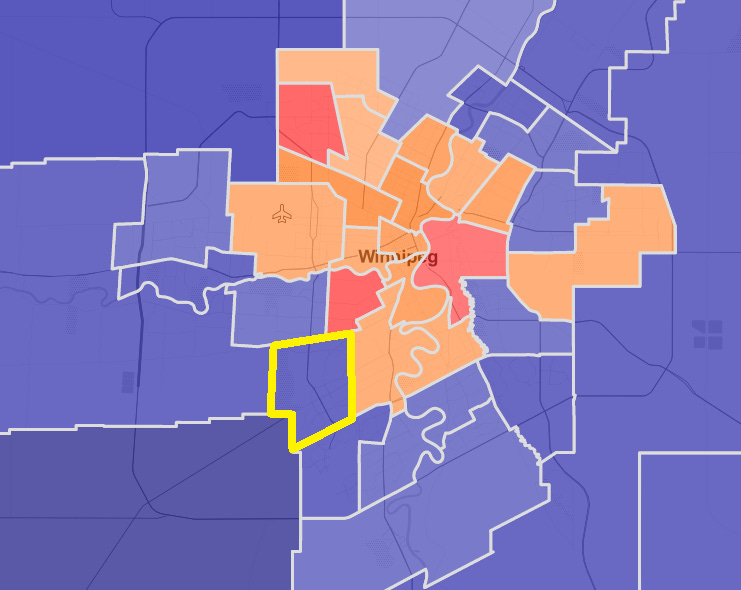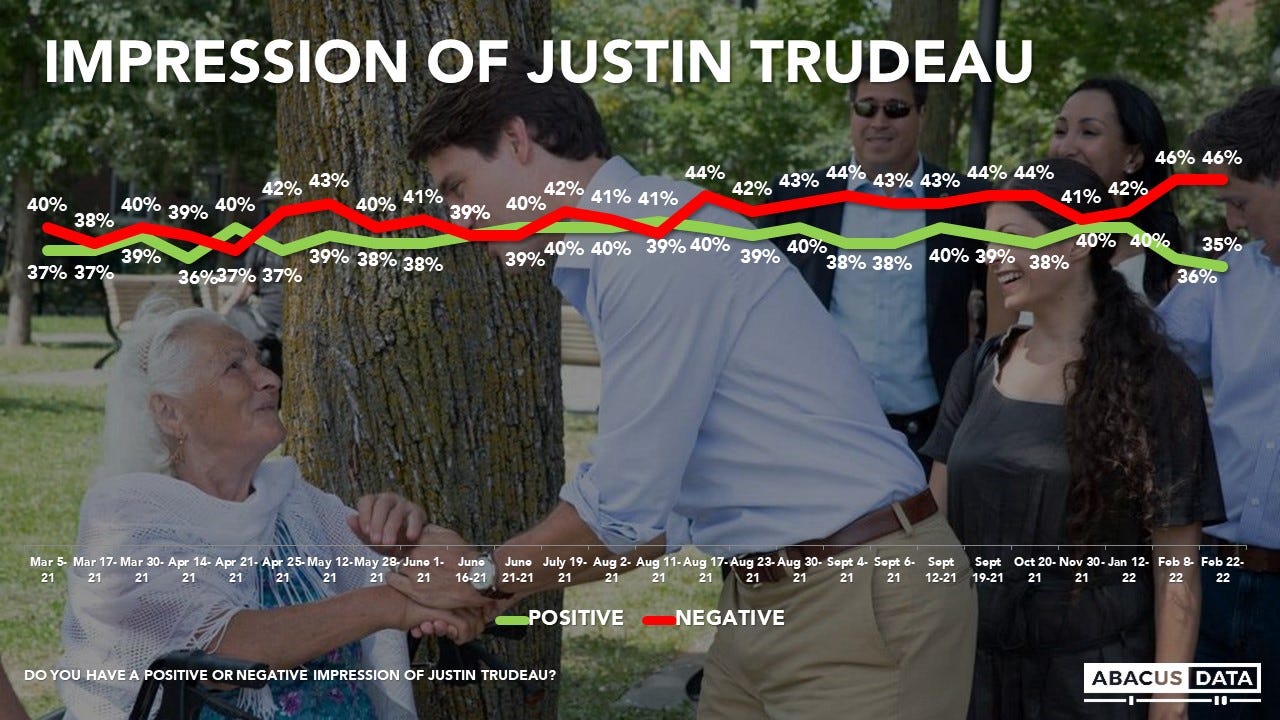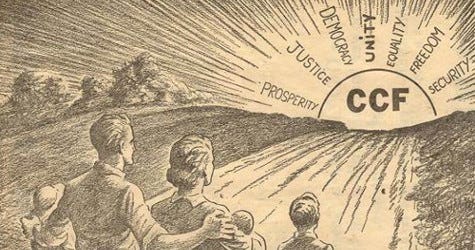The Weekly Writ for Mar. 2
More Conservative leadership news, a Manitoba byelection is coming and the last time the Alberta Liberals tried to come back from the dead.
Welcome to the Weekly Writ, a round-up of the latest federal and provincial polls, election news and political trivia that lands in your inbox every Wednesday morning.
In this instalment of the Weekly Writ, there’s plenty of tidbits about the latest maneuvers in the Conservative leadership race, even if the cast of characters remains unchanged.
We also have news about another leadership race in Saskatchewan and word of a byelection being scheduled in Manitoba.
The polls this week gauge Canadians’ views on federal politics, the Emergencies Act and just what should come next for the Saskatchewan NDP. Is a re-brand in order?
Finally, I profile the Fort Whyte riding in Manitoba and a past leadership race in Alberta, closing with a shared milestone for the two opposition leaders in Ontario.
ALERT for Founding Members of The Writ! To show my gratitude for your generous support, I’m going to hold a virtual meet-and-greet next Tuesday at 8 PM ET. I’ll be sending you an email with all the details in the coming days. If you aren’t a Founding Member but would like to become one, you can can head over to the subscription page.
IN THE NEWS
Lots going on below the surface in Conservative leadership race
We still (I’ll repeat, still) don’t know when the Conservatives will choose a leader and what set of rules will govern the race in terms of barriers to entry, but that doesn’t mean there isn’t a lot going on below the surface.
Ontario MP Pierre Poilievre remains the only declared candidate, and perhaps accordingly his people want this to be over sooner rather than later — for the good of the party, of course, and not because that would benefit Pierre Poilievre.
He has certainly tried to corner the market on the existing Conservative membership, and would likely easily win a contest if only those who are party members today were allowed to vote. That doesn’t mean a short race makes Poilievre a lock, but it does mean that every extra day the contest lasts is an extra day for his (future) opponents to sign up new members.
Finding new members will be key for Jean Charest, if he decides to run. The former leader of the Progressive Conservatives and premier of Quebec from 2003 to 2012 does not have deep links to the existing party membership, but he could be the centralizing figure for the moderates within the party and those who would like to see the Conservatives closer to the centre than where Poilievre would bring them.
He scored an important endorsement this past week in Gérard Deltell, the highest-profile Quebec Conservative MP (who was recently ousted as Quebec lieutenant by interim leader Candice Bergen).
Interestingly, Deltell and Charest were, once upon a time, opponents. Deltell, a former journalist, was the last leader of the Action Démocratique du Québec before it folded itself into François Legault’s Coalition Avenir Québec over a decade ago. That means there is a record of Deltell saying less-than-nice-things about Charest, which Poilievre’s people are happy to point out.
Nevertheless, it does seem that the Charest campaign is getting rolling. He’ll reportedly be holding an “informal” meeting with potential supporters today, just days after he received news that the Mâchurer investigation into alleged corruption within the Quebec Liberal Party during his tenure has been closed. The only obstacle now might be Charest’s own belief in his ability to win.
If he does run, he might have some competition beyond Poilievre. Patrick Brown, the mayor of Brampton, is considering a bid.
Patrick Brown, who flamed out as leader of the Ontario Progressive Conservatives just months before the 2018 provincial election? That Patrick Brown?
It might seem like a long-shot, but apparently not. On last week’s episode of The Writ Podcast, Chad Rogers explained how Brown’s organizational prowess can’t be under-estimated:
We’ll see what happens next. The early days of the 2020 Conservative leadership race was dominated by news of who wasn’t running. For now, we’re still in the tantalizing “will he/she or won’t he/she” phase.
Saskatchewan NDP to name leader in June
Compared to the taking-it-slow approach of the Conservative Party, the Saskatchewan NDP has gotten its act together and has already settled on the rules and the date of its leadership race, less than two weeks after Ryan Meili announced he would be stepping down:

There are no declared candidates yet, though a few influential caucus members like Nicole Sarauer and Trent Wotherspoon are publicly urging MLA Carla Beck to run.
Manitoba byelection set for March 22
Another byelection date has been set, this time for the Manitoba provincial riding of Fort Whyte, which was left vacant after the resignation of former premier Brian Pallister as an MLA in October. Voting will take place on March 22.
See below for a full profile of Fort Whyte, today’s Riding of the Week.
There is one more vacancy in Manitoba that has to be filled in the riding of Thompson after the death of NDP MLA Danielle Adams last year in a car accident, but the vote there has not been scheduled yet.
THIS WEEK’S POLLS
Liberals, Conservatives deadlocked
Two polls over the last week conducted after the imposition of the Emergencies Act (remember that?), and at least partially after the clearing of the occupation of downtown Ottawa by protesters, show the Liberals and Conservatives deadlocked.
The polls by Abacus Data and Ipsos both had the two parties tied, with Abacus giving them 31% support apiece and Ipsos awarding them 32% support. So, really no significant change from the September 2021 election.
The New Democrats were third with 20% and 23%, followed by the Bloc Québécois at 8% and 6%. That actually represents a big difference in Quebec, with Abacus showing the Bloc in a very strong position at 38% and Ipsos showing the Bloc down to 27%.
The People’s Party was at 6% and 4%, while the Greens were at 3% in both polls.
According to Abacus, Prime Minister Justin Trudeau’s personal ratings haven’t recovered. His positives were at just 35%, down from the roughly 40% he enjoyed pre-protests.
One reason, though, that we haven’t seen much of an impact on voting intentions might be that the government’s invoking of the Emergencies Act seems to have gone over pretty well.
Research Co. and Nanos Research, in addition to Abacus, all polled on this question.
Support (or, in the case of Research Co., whether it was justified or not) ranged from 57% in the Abacus poll to 63% in both the Nanos and Research Co. surveys. Opposition was between 28% and 36%.
While the share of those opposed was not insignificant, the Conservative, Bloc and People’s Party have to split that portion of the electorate. The Liberals and New Democrats get a much bigger piece of pie to divide between them.
Few lament O’Toole’s departure
It feels like ages ago that Erin O’Toole was voted out as leader of the Conservative Party. It might seem like ancient history because it appears that very few Canadians were upset about it.
A survey by Narrative Research found that only 16% of Canadians feel O’Toole should have been kept on to lead the Conservatives into the next election. Nearly half of those polled, or 47%, said the Conservatives did the right thing in giving him the boot.
The remaining 36% were unsure. But it doesn’t seem like this decision — on its own — is going to hurt the Conservative Party. The decision they make next will be more impactful.
Majority think Saskatchewan NDP should re-brand
Research Co. conducted a really in-depth survey of Saskatchewan last week (it was crowd-sourced through a GoFundMe!) with lots of really interesting questions on the policies of Premier Scott Moe’s government and its handling of the COVID-19 pandemic, among other things.
But one question caught my eye.
The poll found that 55% of respondents either strongly or moderately agreed that the Saskatchewan NDP should “consider a re-brand before the next election.” That was, indeed, something that the party considered (but rejected) in a post-mortem of their 2020 election performance.
But it wasn’t Saskatchewan Party supporters who thought the NDP should re-brand, it was New Democratic voters themselves. The poll found 61% support among NDP voters for a re-brand.
Maybe it’s time to resurrect the Co-operative Commonwealth Federation?
The poll found the Sask. Party still ahead with 53% support, followed by the NDP at 37%. The Buffalo and Green parties had 3% and 2%, respectively.
The race is close in Regina, where the NDP trails by just a single point, but the Sask. Party holds substantial leads in Saskatoon and in the rest of the province.
Moe had an approval rating of 50% in the survey, with 40% disapproving. Ryan Meili, who will be stepping down as leader, registered 34% approval against 48% disapproval. Among NDP voters, Meili had 77% approval, only a little less than Moe’s 84% approval among Sask. Party voters.
RIDING OF THE WEEK
Fort Whyte (Manitoba)
The Manitoba Progressive Conservatives have been struggling in the polls over the last few months, and the approval ratings for Heather Stefanson, the new premier, don’t suggest the party is experiencing a honeymoon.
Nevertheless, the Manitoba PCs shouldn’t be in any trouble in the upcoming byelection in Fort Whyte.
This riding in southwestern Winnipeg is very solidly PC blue. In the 2019 provincial election, Brian Pallister won the seat for the PCs by a margin of 39 points over both the New Democrats and Liberals, who each managed 18% to Pallister’s 57%. The Greens finished fourth with 7%.

With the exception of the 1990 election, in which the Manitoba Liberals won a portion of the territory covered by the modern riding of Fort Whyte, this part of Manitoba has been consistently voting for the Progressive Conservatives since 1958.
In fact, since 1999 the PCs have always captured a majority of ballots cast in this area of Winnipeg.
So, the Manitoba New Democrats are, to say the least, a long shot. As are the Liberals, who hold only a handful of seats in the legislature.
Voters, however, have been splitting their ticket between provincial and federal campaigns. While Fort Whyte has been solidly in the PC camp, the federal ridings of Winnipeg South and Winnipeg South Centre that cover Fort Whyte have been comfortably won by Justin Trudeau’s Liberals in 2015, 2019 and 2021 (though, to be fair, the Fort Whyte portions of the federal riding are more friendly to the Conservatives).
Currently, the candidates on the ballot will include two former Winnipeg Blue Bombers in Obby Khan for the PCs and Willard Reaves for the Liberals, while the NDP’s banner will be carried by Trudy Schroeder, a veteran of Winnipeg’s arts sector. Local businessman Patrick Allard will also be running as an Independent.
ON THIS DAY in the #EveryElectionProject
Alberta Liberals choose Taylor
March 2, 1974
Alberta has been a tough place for Liberals for, well, a pretty long time. The Alberta Liberals haven’t won an election there for over a century. And, judging by recent election results in the province, they could be in the wilderness for another century.
But on this day 48 years ago, the Liberals chose a leader they hoped would get them back to the promised land, a leader who would turn out to be the only Alberta Liberal who would take the party into four election campaigns.
The 1971 provincial election was a watershed moment in Alberta, as it ushered in the Progressive Conservatives and ended the decades-long Social Credit dynasty. For the Liberals, though, it was a disaster. The party ran a small slate of candidates and managed just 1% of the vote, failing to win a single seat for the first time in the party’s history.
Bob Russell, the leader, resigned after yet another failed attempt win himself a seat in a byelection, finishing with just 6% of the votes in Calgary-Foothills in 1973.
Despite this, the Liberals were still confident that, with a dynamic new leader, they could replace the spiralling Social Credit Party as the chief opposition to Peter Lougheed’s PCs.
The 1974 Alberta Liberal leadership contest had just two candidates.
There was Calgary-based oil executive Nick Taylor, an outspoken 17-year veteran of party politics. Taylor was a 46-year-old father of nine and someone seen as a bit of a “renegade” within the party.
The other candidate was John Borger, a petroleum and engineering consultant from Edmonton, who also happened to be a former football player for the Calgary Stampeders. (Lots of CFL content in this Weekly Writ.)
According to the Edmonton Journal, while Taylor served “stomach-warming fuel” at his suite at the convention in Edmonton, Borger “doesn’t drink or smoke. He proudly serves only coffee and cookies at his receptions.”
In addition to style, it was the two candidates’ positions on collaboration with the Liberal Party of Canada that distinguished them. Taylor wanted more separation between the provincial and federal wings, saying that a Robert Stanfield-led PC victory in the upcoming federal election would be helpful, since “then I’m rid of the albatross of having to explain every asinine move Ottawa makes.”
Borger wanted a closer relationship with the two parties with an eye toward electing both provincial and federal Liberals in Alberta. He didn’t want to be a spokesman for Pierre Trudeau in the province, but instead be a “representative from Alberta in the councils of the national party.”
When the votes were counted, Taylor emerged as the victor with 366 votes to 293 for Borger. Another 78 delegates — more than the gap that separated Taylor and Borger — abstained.
Of course, Taylor was taking over a struggling party with no representation in the legislature. Personally wealthy, the party would have to lean on Taylor’s own resources for support.
But he was still realistic, telling reporters after his victory that after the next election he “wouldn’t be unhappy with 70 Tories in the government and five of us on the other side at first.”
Even that modest ambition, though, turned out to be beyond his capabilities. In the 1975 election, the Liberals were again shutout and won only 5% of the vote. That improved slightly to 6% in 1979 and dropped back again to 2% in 1982.
The 1986 election, though, turned out to be the turning point for Taylor and the Liberals. The party won four seats — including Taylor’s riding of Westlock-Sturgeon — and 12% of the vote, placing them as the third party in the legislature behind Don Getty’s governing PCs and Ray Martin’s New Democrats.
Before long, though, Taylor would face a leadership challenge and was replaced by Edmonton mayor Laurence Decore. In 1993, Decore would lead the Liberals the closest to power they have ever been since their 1917 election win, returning the party to the role of the official opposition.
Staying on as an MLA for a few more terms, Taylor would later be named to the Senate by Jean Chrétien. He passed away in 2020. (Dave Cournoyer of Daveberta.ca has a good retrospective here.)
The Alberta Liberal Party that Taylor led for nearly 15 years is now a shadow of its former self, once again shutout of the legislature and coming off an election in which it earned only 1% of ballots cast. It could use another Nick Taylor.
MILESTONE WATCH
Horwath and Del Duca mark anniversaries
In a bit of an odd coincidence, the two leaders of the two biggest opposition parties in the Ontario legislature will both mark an anniversary on Monday.
For Steven Del Duca, it will be his two-year anniversary as leader of the Ontario Liberals. For Andrea Horwath, Monday marks 13 years as leader of the Ontario New Democrats.
That’s a contrast, to say the least. Del Duca is only a few months away from leading his party into his first campaign. Horwath is about to embark on her fourth. She is the longest-serving leader of any major federal or provincial party in Canada.
With four elections under her belt, Horwath will tie past Ontario NDP/CCF leaders Bob Rae, Donald MacDonald and Ted Joliffe. No past leader has been at the helm for five elections. After 13 years in the opposition, Horwath might have to win this upcoming campaign to have a shot at five elections and a new record.
That’s it for the Weekly Writ this week. The next episode of The Writ Podcast will be dropping on Friday. As always, the episode will land in your inbox but you can also find it on Apple Podcasts and Spotify. And don’t forget to subscribe to my YouTube Channel, where I post interviews from the podcast, election videos and livestreams!





You got my curiosity regarding the desire of NDP voters in Saskatchewan for a re-branding. Is there some indication of what that means? Just tired of the name or a desire for new policies? The Newer Saskatchewan Party?